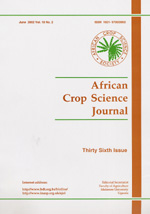
|
African Crop Science Journal
African Crop Science Society
ISSN: 1021-9730
EISSN: 1021-9730
Vol. 5, No. 4, 1997, pp. 419-424
|
 Bioline Code: cs97047
Bioline Code: cs97047
Full paper language: English
Document type: Short Communication
Document available free of charge
|
|
|
African Crop Science Journal, Vol. 5, No. 4, 1997, pp. 419-424
| fr |
Wagih, M.E.
Résumé
Afin qu'on puisse mener a terme les methodologies appropriees pour cultiver
les choux caraibes, les choux caraibes a croissance demi-spontanee de Papua
New Guinea (swt), dont la variete avait ete cultivee sur un champ de
collection du plasme germinatifet ayant aussi 437 varietes et dont la
resistance est tres elevee a la brulure des feuilles et aussi la
sensibilite egalement elevee aux maladies virales, la variete etait
utilisee comme source principale de multiplication de semences. La
floraison naturelle etait habituelle, mais aux degre variants, parmi les
varietes. Toutes les varietes examinees on produit 4 a 5 boutons a fleurs
par plante avec une moyenne de 15,000 graines, d'une potentialite viable
par bouton a fleurs . Les semences ont ete cultivees aseptiquement in vitro
en utilisant une technique de conservation de semences, qui ont ete
ensuite, conservees dans les serres anti-parasitaires pour une periode de 8
mois et sous la surveillance reguliere. Les plantes regenerees des semences
traitees a 60 C et 55 C respectivemment pour une duree de 120 min ont
demeure saines des symptomes des maladies virales de chou caraibe. Les deux
traitements, par contre, ont reduit, d'une maniere considerable, leur
faculte germinative de 92.16% a 42.24% et 62.28% respectivemment. Malgre
quils aient pu reduire les symptomes des maladies aux niveaux plus bas que
les echantillons moins non traites, les experiences menees sur six autres
traitements, n'ont pas reussi a eliminer, aux degres variants, les
symptomes des maladies. En plus de la variabilite morphologique et
physiologique parmi les semis, les plantes ont demontre une sensibilite
variante a la maladie des brulures des feulles. L'importance d'utiliser la
thermotherapie avec la technique (SRC) dans la conservation du
plasmegerminatif, la selection et l'etablissement des qarantaines est mis
au point.
Mots Clés
Alomae and bobone viruses, Colocasia esculenta, dasheen mosaic, tissue culture, thermotherapy
|
| |
| en |
Eradication of taro viruses from seedlings via seed rescue culture coupled with thermotherapy
Wagih, M.E.
Abstract
In order to investigate appropriate methodologies for producing virus-free
taro plants, Papua New Guinea semi-wild taro (SWT), which had been grown in
a field germplasm collection of 437 cultivars and exhibited high degree of
field resistance to leaf blight and high susceptibility to taro viral
diseases, was used as a mother source of seeds. Natural flowering was
common, to varying degree, among all cultivars. All SWT plants examined
produced 4-5 flower heads per plant with an average of 15,000 potentially
viable seeds per head. Seeds were grown aseptically in vitro via a
seed rescue culture (SRC) technique and further maintained in an
insect-proof greenhouse for a period of 8 months and regularly inspected.
Plants regenerated from seeds treated at 60 C for 120 min and at 55 C for
120 min remained free of all taro viral disease symptoms. Both treatments,
however, significantly reduced germination from 92.16% to 42.24% and 62.28%
respectively. Six other treatments, although all reduced symptoms below
those of the untreated control, failed to various degrees to eradicate the
symptoms. In addition to morphological and physiological variability among
seedlings, the plants showed a range of susceptibility to leaf blight. The
importance of using thermotherapy with the SRC technique in taro germplasm
conservation, breeding and quarantine is highlighted.
Keywords
Alomae and bobone viruses, Colocasia esculenta, dasheen mosaic, tissue culture, thermotherapy
|
| |
© Copyright 1997 - African Crop Science Society
|
|
